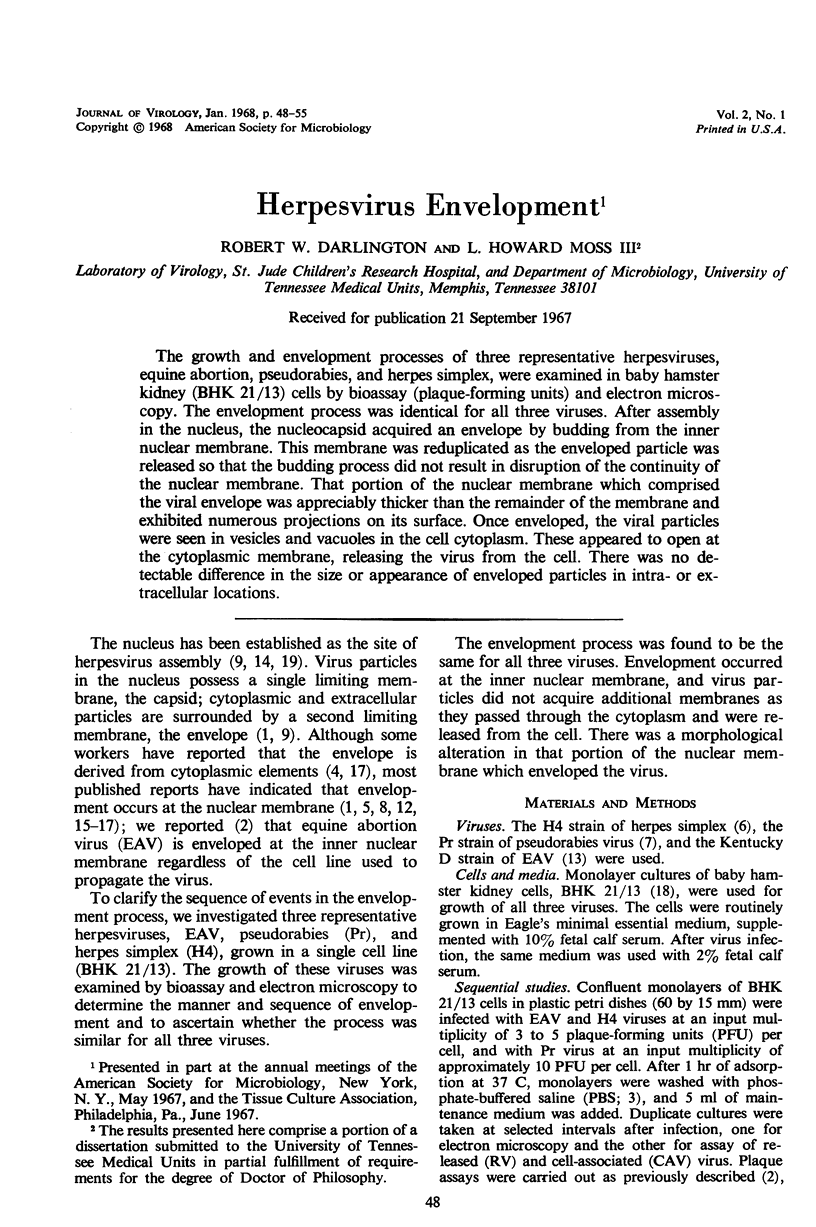Abstract
The growth and envelopment processes of three representative herpesviruses, equine abortion, pseudorabies, and herpes simplex, were examined in baby hamster kidney (BHK 21/13) cells by bioassay (plaque-forming units) and electron microscopy. The envelopment process was identical for all three viruses. After assembly in the nucleus, the nucleocapsid acquired an envelope by budding from the inner nuclear membrane. This membrane was reduplicated as the enveloped particle was released so that the budding process did not result in disruption of the continuity of the nuclear membrane. That portion of the nuclear membrane which comprised the viral envelope was appreciably thicker than the remainder of the membrane and exhibited numerous projections on its surface. Once enveloped, the viral particles were seen in vesicles and vacuoles in the cell cytoplasm. These appeared to open at the cytoplasmic membrane, releasing the virus from the cell. There was no detectable difference in the size or appearance of enveloped particles in intra- or extracellular locations.
Full text
PDF







Images in this article
Selected References
These references are in PubMed. This may not be the complete list of references from this article.
- BECKER P., MELNICK J. L., MAYOR H. D. A MORPHOLOGIC COMPARISON BETWEEN THE DEVELOPMENTAL STAGES OF HERPES ZOSTER AND HUMAN CYTOMEGALOVIRUS. Exp Mol Pathol. 1965 Feb;76:11–23. doi: 10.1016/0014-4800(65)90020-1. [DOI] [PubMed] [Google Scholar]
- DULBECCO R., VOGT M. Plaque formation and isolation of pure lines with poliomyelitis viruses. J Exp Med. 1954 Feb;99(2):167–182. doi: 10.1084/jem.99.2.167. [DOI] [PMC free article] [PubMed] [Google Scholar]
- Darlington R. W., James C. Biological and morphological aspects of the growth of equine abortion virus. J Bacteriol. 1966 Jul;92(1):250–257. doi: 10.1128/jb.92.1.250-257.1966. [DOI] [PMC free article] [PubMed] [Google Scholar]
- EPSTEIN M. A. Observations on the mode of release of herpes virus from infected HeLa cells. J Cell Biol. 1962 Mar;12:589–597. doi: 10.1083/jcb.12.3.589. [DOI] [PMC free article] [PubMed] [Google Scholar]
- FALKE D., SIEGERT R., VOGELL W. [Electron microscopic findings on the problem of double membrane formation in herpes simplex virus]. Arch Gesamte Virusforsch. 1959;9:484–496. [PubMed] [Google Scholar]
- KAPLAN A. S. A study of the herpes simplex virus-rabbit kidney cell system by the plaque technique. Virology. 1957 Dec;4(3):435–457. doi: 10.1016/0042-6822(57)90078-8. [DOI] [PubMed] [Google Scholar]
- KAPLAN A. S., VATTER A. E. A comparison of herpes simplex and pseudorabies viruses. Virology. 1959 Apr;7(4):394–407. doi: 10.1016/0042-6822(59)90068-6. [DOI] [PubMed] [Google Scholar]
- MCGAVRAN M. H., SMITH M. G. ULTRASTRUCTURAL, CYTOCHEMICAL, AND MICROCHEMICAL OBSERVATIONS ON CYTOMEGALOVIRUS (SALIVARY GLAND VIRUS) INFECTION OF HUMAN CELLS IN TISSUE CULTURE. Exp Mol Pathol. 1965 Feb;76:1–10. doi: 10.1016/0014-4800(65)90019-5. [DOI] [PubMed] [Google Scholar]
- MORGAN C., ELLISON S. A., ROSE H. M., MOORE D. H. Structure and development of viruses as observed in the electron microscope. I. Herpes simplex virus. J Exp Med. 1954 Aug 1;100(2):195–202. doi: 10.1084/jem.100.2.195. [DOI] [PMC free article] [PubMed] [Google Scholar]
- MORGAN C., ROSE H. M., HOLDEN M., JONES E. P. Electron microscopic observations on the development of herpes simplex virus. J Exp Med. 1959 Oct 1;110:643–656. doi: 10.1084/jem.110.4.643. [DOI] [PMC free article] [PubMed] [Google Scholar]
- PALADE G. E. Studies on the endoplasmic reticulum. II. Simple dispositions in cells in situ. J Biophys Biochem Cytol. 1955 Nov 25;1(6):567–582. doi: 10.1083/jcb.1.6.567. [DOI] [PMC free article] [PubMed] [Google Scholar]
- Patrizi G., Middelkamp J. N., Reed C. A. Reduplication of nuclear membranes in tissue-culture cells infected with guinea-pig cytomegalovirus. Am J Pathol. 1967 May;50(5):779–790. [PMC free article] [PubMed] [Google Scholar]
- RANDALL C. C., LAWSON L. A. Adaptation of equine abortion virus to Earle's L cells in serum-free medium with plaque formation. Proc Soc Exp Biol Med. 1962 Jul;110:487–489. doi: 10.3181/00379727-110-27558. [DOI] [PubMed] [Google Scholar]
- REISSIG M., MELNICK J. L. The cellular changes produced in tissue cultures by herpes B virus correlated with the concurrent multiplication of the virus. J Exp Med. 1955 Mar 1;101(3):341–352. doi: 10.1084/jem.101.3.341. [DOI] [PMC free article] [PubMed] [Google Scholar]
- RUEBNER B. H., MIYAI K., SLUSSER R. J., WEDEMEYER P., MEDEARIS D. N., Jr MOUSE CYTOMEGALOVIRUS INFECTION. AN ELECTRON MICROSCOPIC STUDY OF HEPATIC PARENCHYMAL CELLS. Am J Pathol. 1964 May;44:799–821. [PMC free article] [PubMed] [Google Scholar]
- STOKER M. G., SMITH K. M., ROSS R. W. Electron microscope studies of HeLa cells infected with herpes virus. J Gen Microbiol. 1958 Oct;19(2):244–249. doi: 10.1099/00221287-19-2-244. [DOI] [PubMed] [Google Scholar]
- STOKER M., MACPHERSON I. SYRIAN HAMSTER FIBROBLAST CELL LINE BHK21 AND ITS DERIVATIVES. Nature. 1964 Sep 26;203:1355–1357. doi: 10.1038/2031355a0. [DOI] [PubMed] [Google Scholar]
- Shipkey F. H., Erlandson R. A., Bailey R. B., Babcock V. I., Southam C. M. Virus biographies. II. Growth of herpes simplex virus in tissue culture. Exp Mol Pathol. 1967 Feb;6(1):39–67. doi: 10.1016/0014-4800(67)90005-6. [DOI] [PubMed] [Google Scholar]
- Siminoff P., Menefee M. G. Normal and 5-bromodeoxyuridine-inhibited development of herpes simplex virus. An electron microscope study. Exp Cell Res. 1966 Nov-Dec;44(2):241–255. doi: 10.1016/0014-4827(66)90429-0. [DOI] [PubMed] [Google Scholar]









